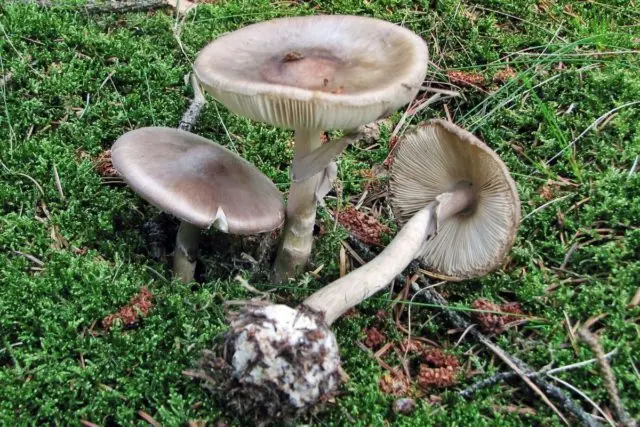Contents
Fly agaric porphyry is one of the representatives of the Amanitaceae family. It belongs to poisonous fruit bodies, is capable of causing a hallucinogenic effect, due to the fact that the fungus contains substances such as tryptamines (5-methoxydimethyltryptamine, bufotenin, dimethyltryptamine).
Description of fly agaric porphyry
The porphyry fly agaric (gray or Amanita porphyria) is not very popular, especially when compared with the more well-known representatives of this family (panther and red). Although mushrooms have common features that are inherent in most fly agarics. The main distinguishing feature of the porphyry representative is the coloring of the hat. The upper part of the fruit body may have a purple or purple-brown hue. Coloring depends on several factors – age, place of growth and soil composition.
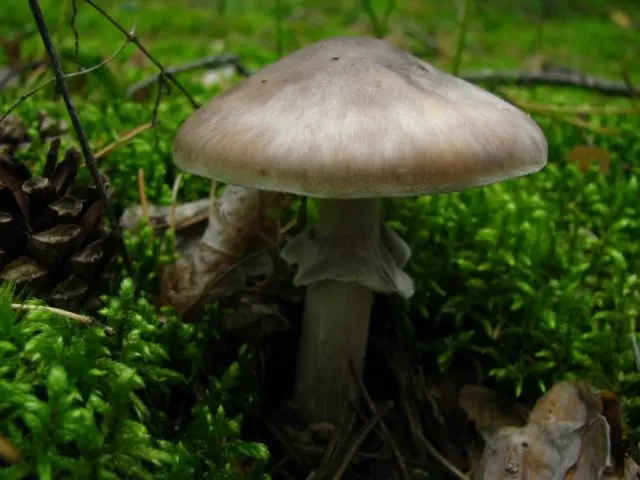
Cap Description
In the porphyritic fly agaric, the top has an ovoid-bell-shaped shape. As the fungus grows, it becomes flat, and the bulge on it is invisible. In diameter, the hat can vary from 5 to 11 cm.
The color is most often gray-brown with violet-gray, but sometimes there is also a purple tint. On a wet surface, white or purple warts are visible, which are more like rare membranous flakes. A faint striped pattern runs along the edge of the cap.
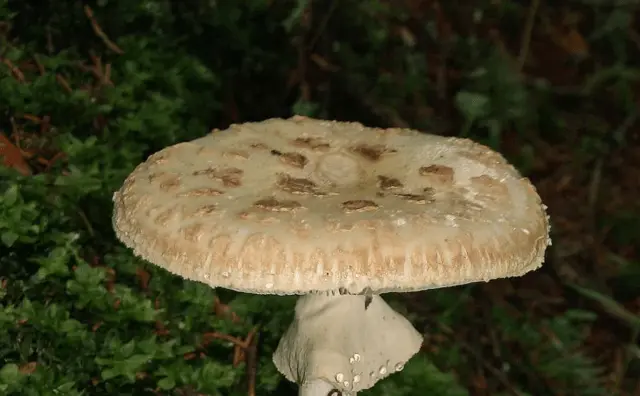
The plates under the upper part of the fruiting body are located close to each other and in large numbers, thin and soft to the touch. They rarely grow to the stem, the color is white, which, as the fly agaric grows older, acquires a beige tint.
The flesh of the porphyry fungus is white and thin. It has not only an unpleasant taste, but also a strong pungent odor that resembles the aroma of potatoes or musty radish.
Description of the leg
In a fly agaric, it can reach a diameter of 2 cm and a height of 13 cm. The shape of the lower part of the fruiting body is similar to a cylinder with a thickened area near the base. The color of the stem varies from pure white to slightly gray.

Twins and their differences
The porphyry fly agaric does not have twins. Therefore, confusing it with other species is extremely problematic. Beginning lovers of quiet hunting can confuse this fly agaric with gray-pink. It does not have such a sharp and unpleasant aroma, and the color of the hat is pronounced gray-pink. The mushroom belongs to conditionally edible specimens, therefore it cannot cause much harm to human health.
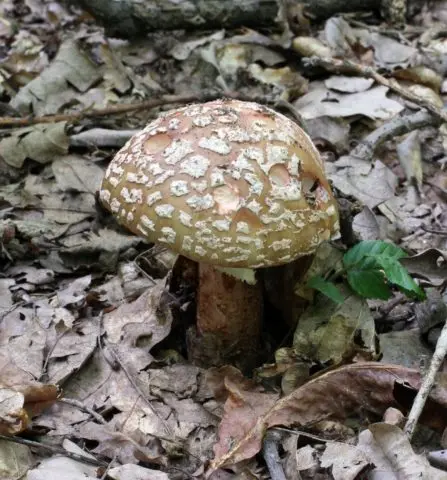
The porphyritic fly agaric can be confused by smell with the grebe-shaped counterpart, but the latter has a completely different color palette.
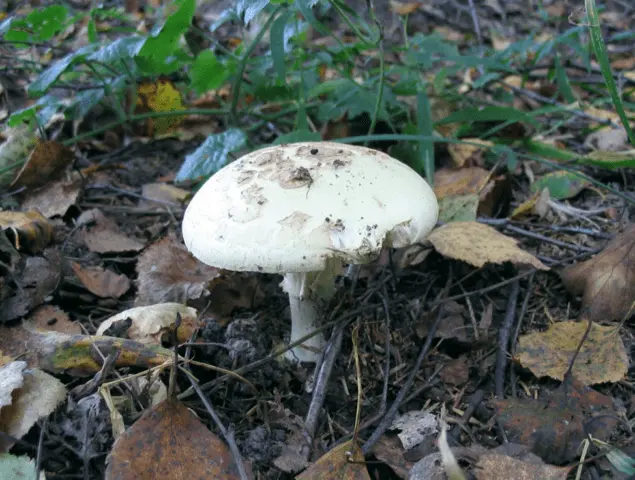
Where and how does the porphyry fly agaric grow
The porphyritic fly agaric prefers coniferous forests, where it can form mycorrhiza together with spruce and pine trees. Sometimes there is a mushroom in birch groves.
Fruiting bodies rarely grow in groups of 2-3 specimens, most often they can be seen singly.
Fruiting begins in July, and the last harvest is observed at the end of October. Geographically, mushrooms are found in all forests of Our Country, where there are coniferous plantations and birches grow. The most abundant growth occurs in Scandinavia and Central Asia. They are also found in some European countries. It should be noted that exceptionally poor acidic soil is suitable for the porphyritic fly agaric. It is often possible to observe fruiting bodies at an altitude of 1600 m above the horizon, in mountainous areas.
Edible porphyry fly agaric or poisonous
The use of porphyry fly agaric in food is prohibited, since the mushroom is not only not edible, but also poisonous. It contains dangerous toxins, which are also found in the panther fly agaric. With the use of the fruiting body in its raw form, even in small quantities, tropane or mycoatropine syndromes develop. The poison does not disappear even after heat treatment, since it cannot be destroyed by high temperatures.
In addition to the dangerous toxin, the composition of the porphyritic fly agaric includes 5-MeO-DMT, bufotenin and DMT. Despite the fact that these components have insignificant concentrations, their entry into the body negatively affects the well-being of a person.
Symptoms of poisoning and first aid
Mushroom poisoning can occur for a number of different reasons, among which not only the intentional use of fly agaric is possible, but also its accidental ingestion into the stomach. In any case, it is important to know not only about the symptoms of body intoxication, but also about how to help yourself and your loved one before the ambulance arrives.

The main and very first symptoms that you should pay attention to:
- feeling of constant nausea;
- profuse vomiting that does not end after taking absorbents;
- increase in body temperature up to 38-40 ° C;
- stomach ache;
- frequent diarrhea – at least 10 times a day;
- numbness of the limbs (arms and legs begin to get cold);
- the pulse becomes fuzzy, weak;
- inflammation of the small intestine and stomach develops.
If the amount of fly agaric eaten was significant, then additional, more pronounced symptoms may develop, which require immediate hospitalization of the victim:
- the appearance of hallucinations;
- a state that borders on insanity;
- the patient begins to rave, the mind becomes confused, speech becomes illegible.
When the first signs of poisoning appear, it is necessary to call an ambulance, since toxins quickly spread along with the blood, entering all vital organs and disrupting their work. If medical assistance is not provided in the first 24 hours, then death is possible.
Prior to the arrival of an ambulance, it is necessary to provide a person with emergency assistance, which consists of the following:
- The victim should drink a lot and often so that dehydration does not occur. At the same time, it is recommended to use cold mineral water, cooled strong tea, plain water with the addition of salt and sugar.
- Bed rest. The victim should not move and lead an active lifestyle so that the body does not waste energy and strength. Also, in case of poisoning, a person can faint and receive significant damage and injury.
- Gastric lavage. If there is no vomiting, then experts recommend calling it yourself. To do this, you need to drink warm water.
- intake of absorbents. When the stomach is cleared, activated charcoal and the like can be given to the patient.
Ambulance doctors most often hospitalize the victim, because to cleanse the body of toxins, it is necessary to set up droppers with saline and vitamins. Recovery, if the therapy is not only correct, but also timely, occurs within a day.
Interesting facts about porphyry fly agarics
Porphyritic fly agarics have features that are inherent in many members of the family, but not every mushroom picker knows about them:
- Fruiting bodies contain acid, which can not only adversely affect human health, but also lead to the death of brain cells.
- Despite the fact that the mushroom is poisonous, there are few deaths from poisoning. Since the fly agaric does not look like an edible species in any way, it is simply impossible to confuse it with an agaric or mushroom. In addition, an instant lethal outcome can occur only when a large amount is consumed, at least 15 hats.

- In ancient times, fly agaric acted as the only intoxicating substance. The peoples of Siberia used it to conduct ritual ceremonies, since mushrooms had a hallucinogenic effect, which made it possible to communicate with otherworldly forces and spirits.
- They eat fly agaric and some animals, such as deer, squirrels, bears and elks. For them, this product is therapeutic.
- Among the Mari and the inhabitants of Mordva, fly agarics were held in special esteem, since they were considered the food of spirits and gods.
- Some representatives and adherents of traditional medicine claim that the poisonous product can be used as a cure for joint diseases, oncology, colds and hypertension. Since there is no scientific evidence for this fact, it is not recommended to engage in such self-treatment. It can be life threatening.
- Porphyry fly agaric in France is used as a cure for insomnia, using for this purpose an extract from the fruiting bodies.
Conclusion
The porphyry fly agaric is a poisonous mushroom that is difficult to confuse with any edible species. Therefore, cases of poisoning by them are extremely rare.










